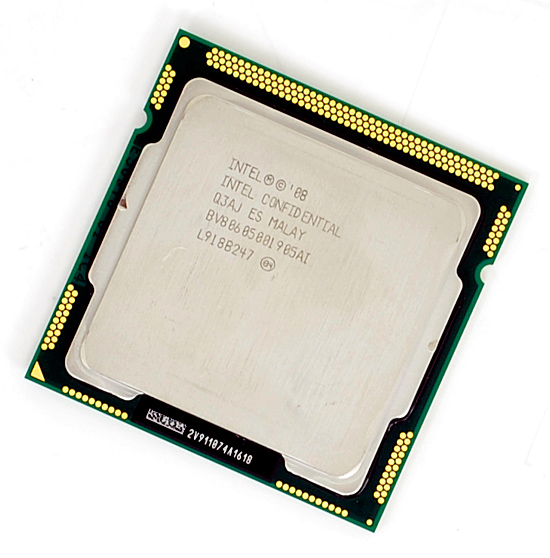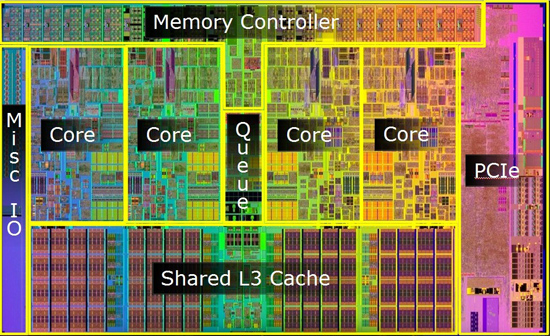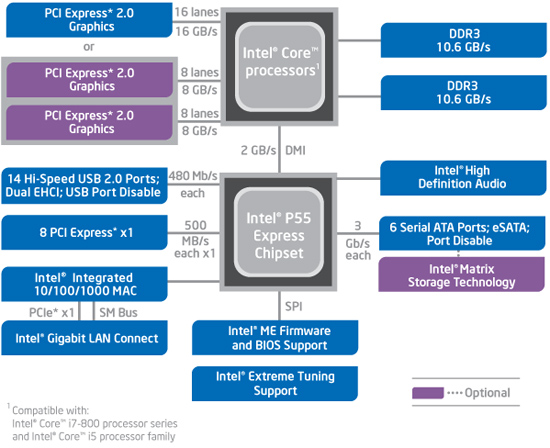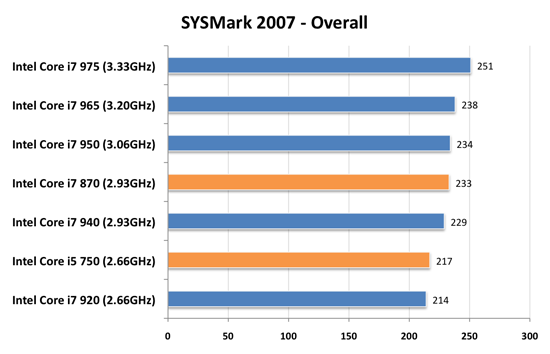Intel's Core i7 870 & i5 750, Lynnfield: Harder, Better, Faster Stronger
by Anand Lal Shimpi on September 8, 2009 12:00 AM EST- Posted in
- CPUs
Intel is on the verge of transitioning to 32nm. We'll see the first parts this year. What do you do with your 45nm fabs when you start moving volume away from them? Make really cheap quad-core Nehalems of course:

I'm talking $196. I'm talking faster than AMD's entire lineup. I'm talking about arguably the best processor of 2009. I'm talking about Lynnfield, and here's its backside:

Mmm
I spent much of the past year harping on AMD selling Nehalem-sized Phenom IIs for less than Intel sold Nehalems. With Lynnfield, Intel actually made Nehalem even bigger all while driving prices down. Like I said, what do you do when you're still making boatloads of money in a recession and are about to start emptying your 45nm fabs?
I should clear things up before we progress much further. Lynnfield is the codename for mainstream 45nm quad-core Nehalem, while Bloomfield refers to the first Nehalem launched at the end of 2008:
| Processor | Manufacturing Process | Die Size | Transistor Count | Socket |
| Bloomfield | 45nm | 263 mm2 | 731M | LGA-1366 |
| Lynnfield | 45nm | 296 mm2 | 774M | LGA-1156 |
Despite being cheaper, Lynnfield is larger than Bloomfield. The larger die is due to one major addition: an on-die PCIe controller.

Bloomfield, The First Nehalem, circa 2008

Lynnfield, Nehalem for All, circa 2009
The pink block to the right of the die is the PCIe controller, that's 16 PCIe 2.0 lanes coming right off the chip. Say hello to ultra low latency GPU communication. You'd think that Intel was about to enter the graphics market or something with a design like this.
Sacrifices were made to reduce CPU, socket and board complexity. Gone are the two QPI links that each provided 25.6GB/s of bandwidth to other CPUs or chips on the motherboard. We also lose one of the three 64-bit DDR3 memory channels, Lynnfield only has two like a normal processor (silly overachieving Bloomfield).

Intel's Bloomfield Platform (X58 + LGA-1366)
The sum is that Lynnfield is exclusively single-socket; there will be no LGA-1156 Skulltrail. While the dual-channel memory controller isn't really a limitation for quad-core parts, six and eight core designs may be better suited for LGA-1366.

Intel's Lynnfield Platform (P55 + LGA-1156)
The loss of QPI means that Lynnfield doesn't have a super fast connection to the rest of the system, but with an on-die PCIe controller it doesn't matter: the GPU is fed right off the CPU.
The Lineup
We get three Lynnfield CPUs today: the Core i7 870, Core i7 860 and the Core i5 750. Intel's branding folks told us that the naming would make sense one we saw the rest of the "Core" parts introduced; yeah that was pretty much a lie. At least there aren't any overlapping part numbers (e.g. Core i5 860 and Core i7 860).
The i7 in this case denotes four cores + Hyper Threading, the i5 means four cores but no Hyper Threading. The rules get more complicated as you bring notebooks into the fray but let's momentarily bask in marginal simplicity.
| Processor | Clock Speed | Cores / Threads | Maximum Single Core Turbo Frequency | TDP | Price |
| Intel Core i7-975 Extreme | 3.33GHz | 4 / 8 | 3.60GHz | 130W | $999 |
| Intel Core i7 965 Extreme | 3.20GHz | 4 / 8 | 3.46GHz | 130W | $999 |
| Intel Core i7 940 | 2.93GHz | 4 / 8 | 3.20GHz | 130W | $562 |
| Intel Core i7 920 | 2.66GHz | 4 / 8 | 2.93GHz | 130W | $284 |
| Intel Core i7 870 | 2.93GHz | 4 / 8 | 3.60GHz | 95W | $562 |
| Intel Core i7 860 | 2.80GHz | 4 / 8 | 3.46GHz | 95W | $284 |
| Intel Core i5 750 | 2.66GHz | 4 / 4 | 3.20GHz | 95W | $196 |
Keeping Hyper Threading off of the Core i5 is purely done to limit performance. There aren't any yield reasons why HT couldn't be enabled.
Intel was very careful with both pricing and performance of its Lynnfield processors. I'm going to go ahead and say it right now, there's no need for any LGA-1366 processors slower than a Core i7 965:

This is only one benchmark, but it's representative of what you're about to see. The Core i7 870 (LGA-1156) is as fast, if not faster, than every single LGA-1366 processor except for the ones that cost $999. Its pricing is competitive as well:

For $196 you're getting a processor that's faster than the Core i7 920. I'm not taking into account motherboard prices either, which are anywhere from $50 - $100 cheaper for LGA-1156 boards. I don't believe LGA-1366 is dead, but there's absolutely no reason to buy anything slower than a 965 if you're going that route.










343 Comments
View All Comments
yacoub - Tuesday, September 8, 2009 - link
lol, what a stupid comment. yes it's "cheating" to benchmark the processor the way it comes out of the box, which also happens to be how it is used in the real world environment.Voo - Tuesday, September 8, 2009 - link
Well there are many users who don't bother with overclocking so the tests aren't "illegal" or anything.But I tend to agree that most users who would be interested in buying an i7 920 or i7 860 would overclock it, so turbo mode wouldn't help at all, as we see with the OC results.
I'm curious if PCI-e on die is the only problem and if we'll see new chips who benefit from turbo mode even when overclocked. After all the principle behind turbo mode doesn't change if you overclock, does it?
james jwb - Tuesday, September 8, 2009 - link
IF that's true, i'm not at all happy with this review. But i'll wait for someone else to confirm this for obvious reasons... anand, confirm!Voo - Tuesday, September 8, 2009 - link
You read the text, didn't you? It was mentioned several times..james jwb - Tuesday, September 8, 2009 - link
i don't have time to read through all of it right now, was just flicking through and immeditaly thought to ask the question. I will read it fully later on, though.Hence why i asked the question. You say "it", as in which way, benches had turbo, benches didn't?
snakeoil - Tuesday, September 8, 2009 - link
yes again, turbo was on for all the benchmarks which is illegal and biased.maxxcool - Tuesday, September 8, 2009 - link
yes, the federal government says making a feature that makes your product better is legal.JarredWalton - Tuesday, September 8, 2009 - link
Illegal and biased? Yes, Intel is illegally making their CPUs run better at all workloads for normal users that don't overclock. Someone should arrest them! What would be biased is to test these CPUs in a fashion that artificially limits performance. Sure, it would be nice to see performance compared with and without Turbo enabled, but generally there's not enough time to run every potentially interesting test scenario.snakeoil - Tuesday, September 8, 2009 - link
there you go, finally you said it.all the benchmarks have at least 600 mhz over the processor's stock speed.
that is outrageous, then if you want to compare the result with phenom 2 you have to overclock phenom 2 at least 600 mhz over stock speed.
just to be fair
Anand Lal Shimpi - Tuesday, September 8, 2009 - link
The processor's stock speed is variable according to the workload it's running, that's what turbo mode does. AMD will enable similar functionality in 2011. This is the out-of-box performance of Lynnfield. Turbo mode is a feature of the processor as it has been since the mobile Penryn days (and more recently Nehalem). There's no reason to disable it as no end user would, unless you want to make Intel look worse for some reason.We also ran Turbo on vs. off numbers in the review: http://anandtech.com/cpuchipsets/showdoc.aspx?i=36...">http://anandtech.com/cpuchipsets/showdoc.aspx?i=36...
Take care,
Anand